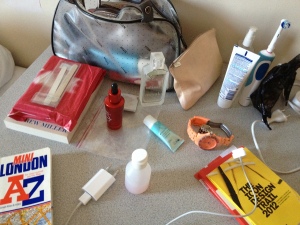An interesting initiative
H&M today launched a global initiative to collect used clothes in the chain’s stores all over the world. From February 2013, customers will be able to hand in used garments in H&M stores in all 48 markets.
That’s an interesting initiative. The results will be vital to follow. H&M states: ”Sustainability is an important part of H&M’s offering, and H&M strives to reduce the environmental impact of clothes throughout their lifecycle.”
Important to remember is also that H&M is extremely clever at marketing. I.e. stressing the points that sounds good, but might not be the whole truth. The ”teflon effect”, to use a term coined by US media.
Signifying is H&M’s policy concerning cotton. Repeatedly the company has reported how it’s now the biggest user in the world of ecological cotton. That sounds good. But how much of all cotton sold by H&M is that? Since the total volumes of cotton used by H&M are huge, as are the damaging effects of conventionally grown cotton, this is the really vital figure. From what we’ve heard only a very small part – a few percents – of all H&M cotton is ecological. But the true figure is not given, instead it’s a company secret. When we’ve put the question directly to H&M representatives, we’ve so far only got the answer that the figure isn’t public. So, interesting to follow all details of the new collecting-of-used-garments initiative.
Posted Dec 6, 2012
Added value – and more
 Just back from London’s yearly Design Festival.
Just back from London’s yearly Design Festival.
Terrible – and fantastic. Like the rest of the overgrowing flora of design weeks around the globe (there are around 100 of them now) this one has it’s base in a conventional furniture fair. Companies presenting news of the season. Thousands and thousands of brand stands – soo boring. Why should I care to examine so many new things? I don’t! Who needs them …
But the London Design Festival – started some ten years ago with 100% Design and Designer’s Block – always had some more to it. Experimental installations, controversial discussions, intriguing exhibitions. The 2012 version was no exception with quality events like the Added Value exhibition (produced by British Crafts Council), the one day conference Global Design Forum and very to the point seminar Design Festivals – Who Needs Them? (scroll down to Thurs 20, 13.00). The latter held at Designjunction – 120,000 sq ft raw industrial space, centrally located, which actually succeeds in balancing creative and commercial in a laid back, to me attractive way.
 More to follow. In the meantime download the Added Value catalogue in full here. Read it! I will – not in the least as a suitable preparation for the discussion with Nina Björk in Gothenburg (se earlier Köp dig fri blog post) next Sunday 30/9. Contemporary craftsmanship as the future of luxury – a refreshing take on Marxism!
More to follow. In the meantime download the Added Value catalogue in full here. Read it! I will – not in the least as a suitable preparation for the discussion with Nina Björk in Gothenburg (se earlier Köp dig fri blog post) next Sunday 30/9. Contemporary craftsmanship as the future of luxury – a refreshing take on Marxism!
Posted Sept 21, 2012
…
All posts in English soon will be available here.
…
Stuff we’ve posted – global version
 March 15. Today is World Consumer Rights Day, held yearly since the 1960:ies, inspired by a John F Kennedy speach, 1962. But consumer’s rights still aren’t well respected, not even well known, Jan Bergtoft, secretary general of the Swedish organization Sveriges Konsumenter, says in a statement. ”Consumers are expected to make conscious
March 15. Today is World Consumer Rights Day, held yearly since the 1960:ies, inspired by a John F Kennedy speach, 1962. But consumer’s rights still aren’t well respected, not even well known, Jan Bergtoft, secretary general of the Swedish organization Sveriges Konsumenter, says in a statement. ”Consumers are expected to make conscious  choices but the information they get is confusing, rambling, biased and sometimes even misleading.” And he concludes it’s now time for politicians and business leaders to make some real change. We agree.
choices but the information they get is confusing, rambling, biased and sometimes even misleading.” And he concludes it’s now time for politicians and business leaders to make some real change. We agree.
March 14. Good design isn’t only about well studied function but as much about emotions. To create relations between object and user, so things aren’t so easily thrown away. The Plug lamp, designed by Swedish trio Form Us With Love, has it all. Interesting function – not only a source of light but also a socket for charging laptops or phones – and a long lasting, lovable form.
 March 13. Gathered in Istanbul are 100 Ikea employees from20 unions in 14 different countries, with the joint ambition to found a global union. The dream is about similar conditions and regulations in all Ikea workplaces, no matter where they are in the world. Top demand is the right to engage in unions. A right that’s been exercised in Ingvar Kamprad’s homeland Sweden since 1886. Shouldn’t the same right exist everywhere?
March 13. Gathered in Istanbul are 100 Ikea employees from20 unions in 14 different countries, with the joint ambition to found a global union. The dream is about similar conditions and regulations in all Ikea workplaces, no matter where they are in the world. Top demand is the right to engage in unions. A right that’s been exercised in Ingvar Kamprad’s homeland Sweden since 1886. Shouldn’t the same right exist everywhere?
February 28. Extremely cool – and produced under transparent conditions – are these slippers from Docksta in northern Sweden. A family business run since 1923, where shoes still are manufactured by hand. This new model, designed by inimitable Mats Theselius, crosses the looks of urban, steady brogues and lazy slippers. Elegant, and comfortable for the broad-footed too.
Posted March 16, 2012
Wow, the latest transparency tool!
 Check out Open label, a hopefully soon existing app – now in private beta – designed by Springwise, a London-based independent innovation firm.
Check out Open label, a hopefully soon existing app – now in private beta – designed by Springwise, a London-based independent innovation firm.
The idea is transparency. For customers to be able to use their mobile phones to scan all sorts of bar codes, to get full information about the products they’re about to buy. Good or bad.
”Using the Open Label iPhone app consumers simply scan a product’s UPC barcode”, writes Danish site Index, Design to improve life. ”There, they can read what others have said about the product, and they can also attach their own comments as to why it is or isn’t worth buying, focusing in particular on topics such as the manufacturer or producers’ environmental, safety, health or animal rights records.”
If the product’s maker has a poor record for sustainability, users can note that on its Open Label. Conversely, users of the app can also ask questions about particular products, and — in Twitter-like fashion — they can “follow” the people and organizations they trust as well.
Here at Köp dig fri! we can’t wait to get our own private beta of Open Label. Until then check out the video at the Index web site, which explains Open Label’s premise more in detail.
Posted Feb 27, 2012
”Indecently cheap products always hide a tragedy”.
 ”A lot of attempts have been made during the last decades to grip the problems of sustainability, mostly from a green angle. Usually that means what companies can do to produce environmentally better and more sustainable products. In Köp dig fri! we have focused another angle. Here we tackle the situation from the perspective of the consumer.
”A lot of attempts have been made during the last decades to grip the problems of sustainability, mostly from a green angle. Usually that means what companies can do to produce environmentally better and more sustainable products. In Köp dig fri! we have focused another angle. Here we tackle the situation from the perspective of the consumer.
In that light you don’t see mainly the ideal ambitions or the ideally produced items – instead you see the whole landscape of products, the landscape of consumerism that any ordinary buyer is confronted with. As a consumer you can’t avoid all the warnings and alarms in the everyday news. Alarms about terrible working conditions in faraway production plants, about poisonous emissions. As a consumer, how am I supposed to connect this kind of information to the products I’m confronted with in the shops, including the ones I’m actually buying – that was one of the questions we set out to answer. Because the connections are there, and we all know it.”
This is how we started our presentation of Köp dig fri! at Designboost in Stockholm in Februari. Read more from the talk by clicking here: Boost Talk.
Photographer: Annika af Klercker/SvD/SCANPIX
Posted Feb 23, 2012
 Radiantly Recycled
Radiantly Recycled
Mats Theselius did it again. He created a chair no one could have thought of before.
A highlight of the just finished Stockholm Furniture Fair the new chair, Hommage à Sigurd Lewerentz, is manufactured from discarded copper plates from the S:t Petri church in Klippan. Designed by Sigurd Lewerentz the church (1963-66) is one of the most famous pieces of late modernist architecture in Sweden.
Mats Theselius arrived in the municipality of Klippan to show the church for his trainees. As it happened – the cooper roof was just being changed. Immediately the designer got the idea to use the discarded material for – something. Källemo, long time producer of Theselius’ furniture, went along with his suggestion, and the result was the chair pictured above.
The shell is made of verdigris green copper plate, the elbow rests of ebony. Added is a jacquard woven textile, inspired by the pattern of the church’s floor. ”The chair is intently composed by different parts, not closely adapted to one another”, Theselius writes in a comment. ”That’s also how I see the design of the church.”
Recycling on a sophisticated level …
123 copies have been made of the chair. That’s exactly the amount the plates from the church’s roof sufficed for.
Posted Feb 11, 2012

